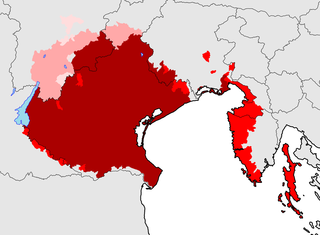
Back Venesiaans Afrikaans Venezianische Sprache ALS ቬኔትኛ Amharic Idioma veneciano AN اللغة البندقية Arabic الفينيسيه ARZ Venecianu AST Venezianisch BAR Venetu kalba BAT-SMG Венециански език Bulgarian
| Venetian | |
|---|---|
| łengoa/łengua vèneta, vèneto | |
| Native to | Italy, Slovenia, Croatia, Montenegro |
| Region | |
Native speakers | 3.9 million (2002)[5] |
Indo-European
| |
| Dialects | |
| Official status | |
Recognised minority language in | |
| Language codes | |
| ISO 639-3 | vec |
| Glottolog | vene1258 |
| Linguasphere | 51-AAA-n |
 Venetian language distribution in Triveneto:
Areas where Venetian is spoken
Areas where Venetian is spoken alongside other languages (Bavarian, Emilian, Friulian, Slovene, Chakavian, Istriot and formerly Dalmatian) and areas of linguistic transition (with Lombard and with Emilian)
Areas of influence of Venetian (over Lombard and over Ladin) | |


Venetian,[7][8] also known as wider Venetian or Venetan[9][10] (łengua vèneta[11] /'lenɡu̯a 'vɛneta/ or vèneto /'vɛneto/), is a Romance language spoken natively in the northeast of Italy,[12] mostly in Veneto, where most of the five million inhabitants can understand it. It is sometimes spoken and often well understood outside Veneto: in Trentino, Friuli, the Julian March, Istria, and some towns of Slovenia, Dalmatia (Croatia) and Bay of Kotor (Montenegro)[13][14] by a surviving autochthonous Venetian population, and in Argentina, Australia, Brazil, Canada, Mexico, the United States and the United Kingdom by Venetians in the diaspora.
Although referred to as an "Italian dialect" (Venetian: diałeto; Italian: dialetto) even by some of its speakers, the label is primarily geographic. Venetian is a separate language from Italian, with many local varieties. Its precise place within the Romance language family remains somewhat controversial. Both Ethnologue and Glottolog group it into the Gallo-Italic branch (and thus, closer to French and Emilian–Romagnol than to Italian).[8][7] Devoto, Avolio and Ursini reject such classification,[15][16][17] and Tagliavini places it in the Italo-Dalmatian branch of Romance.[18]
- ^ a b c Fifth United Nations Conference on the Standardization of Geographical Names: Vol.2. Montreal: United Nations. 1991.
- ^ a b c Holmes, Douglas R. (1989). Cultural disenchantments: worker peasantries in northeast Italy. Princeton University Press.
- ^ a b Minahan, James (1998). Miniature empires: a historical dictionary of the newly independent states. Westport: Greenwood.
- ^ a b Kalsbeek, Janneke (1998). The Čakavian dialect of Orbanići near Žminj in Istria. Studies in Slavic and General Linguistics. Vol. 25. Atlanta.
{{cite book}}: CS1 maint: location missing publisher (link) - ^ Venetian at Ethnologue (18th ed., 2015) (subscription required)
- ^ Tonial, Honório (26 June 2009). "Subsídios para o reconhecimento do Talian" [Subsidies for the recognition of Talian]. Instituto de Investigação e Desenvolvimento em Política Linguística (IPOL) (in Portuguese). Archived from the original on 27 January 2012. Retrieved 21 August 2011.
- ^ a b "Venetian". Glottolog.org.
- ^ a b "Venetian". Ethnologue.
- ^ "Venetan" (PDF). Linguasphere. Retrieved 2018-12-11.
- ^ "Indo-european phylosector" (PDF). Linguasphere. Archived from the original (PDF) on 2014-08-27.
- ^ According to GVIM writing system. The whole page has been written with this standard.
- ^ Ethnologue
- ^ "Language".
- ^ "Italiani all'estero". Italian Network. Archived from the original on 22 July 2011. Retrieved 24 August 2015.
- ^ Devoto, Giacomo (1972). I dialetti delle regioni d'Italia. Sansoni. p. 30.
- ^ Avolio, Francesco (2009). Lingue e dialetti d'Italia. Carocci. p. 46.
- ^ Dialetti veneti, Treccani.it
- ^ Tagliavini, Carlo (1948). Le origini delle lingue Neolatine: corso introduttivo di filologia romanza. Bologna: Pàtron.